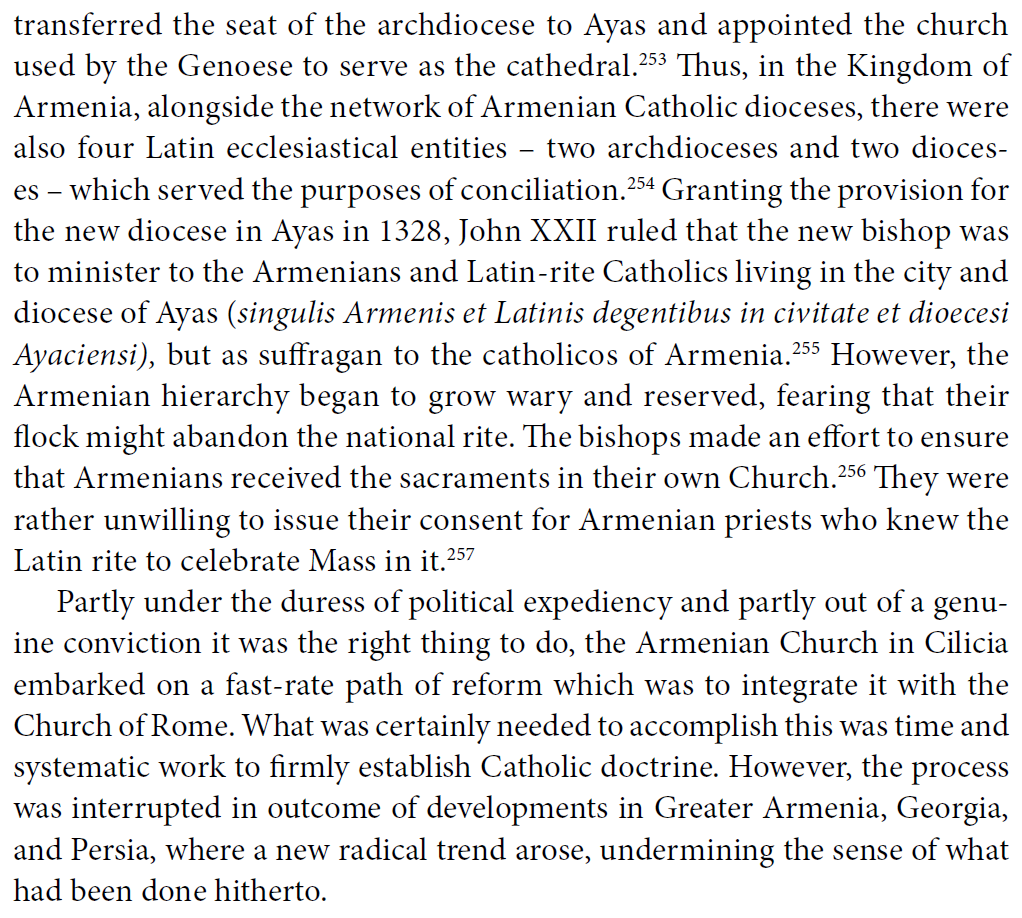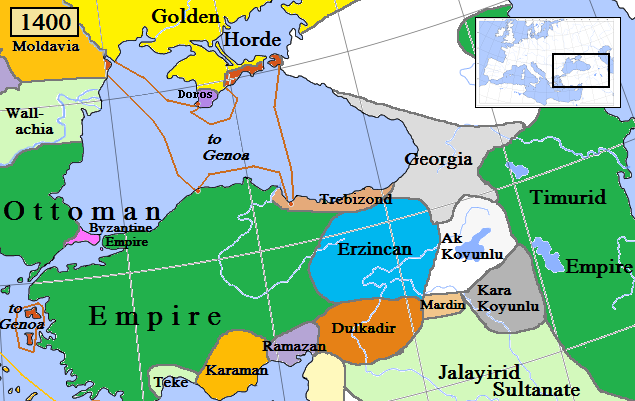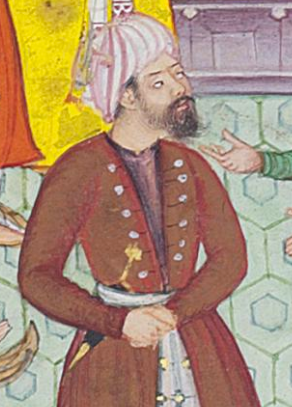There is a high probability that in Erzincan/Yerznka there was an Armenian state that was a vassal of the Mongols.
Information sources are in Armenian.
Page 79 of the pdf file
Erzincan, with a population of 100,000, was a reliable stronghold for the Mongols on the eastern border of the Sultanate of Iconium. The existence of Armenian rule in that zone is in itself a remarkable phenomenon, since it was a unique "island" between the main centers of national political power - North-Eastern Armenia and the Kingdom of Cilicia. It is also noticeable that before the murder of Ter-Sargis and his son Hovhannes in 1276, cultural life in Erzincan had flourished, and the Armenian rulers of the city stood out not only as commissioners of manuscripts, patrons of art and intellectual pursuits, but also Hovhannes himself came up with independent works. Ter-Sargis's energetic activity inevitably aroused the opposition of the regions of the Sultanate of Iconium with anti-Mongol sentiments. The analysis of the events that unfolded in the Near East and in Asia Minor in particular in 1276 serves as a basis for such an assertion. Although the document written in the province of Yekeghyats in 1272 The manuscript notes that “in the time of this (Ter-Sargis and Prince Hovhannes – H. M.) there was peace from the Christians”, it is no secret that this claim is an exaggeration and the prospects of the Armenian government of Erzincan depended on the outcome of the struggle between the government and the Sultanate of Egypt. The next clash of the opponents took place in 1276. The Sultan of Egypt, Rukn ad-Din Baybars Fundukhtar, inflicted a heavy defeat on the Mongol border guard unit in June and, moving into the depths of Asia Minor, reached Caesarea. But Ter-Sargis’s situation in Erzincan had deteriorated significantly even before Fundukhtar’s campaign. The murder of Ter-Sargis and his son Hovhannes took place in February-March 1276, that is, before the appearance of the Mamluk army in Asia Minor. The murder of the Armenian rulers of Erzincan was probably provoked by the same forces that had prompted the Sultan of Mamluk to launch military operations against the Mongols. Persecution of Christians, and Armenians in particular, intensified during the short reign of the Mamluks.
Page 80 of the pdf file
During the 13th century. As Rashid ad-Din testifies, “Fundukhtar arrived in Caesarea and spent a week there. He had a sermon read and minted money in his name... Fundukhtar executed some Christian Armenians and returned.” Thus, the activities of Ter-Sargis and Prince Hovhannes were tragically interrupted, but since the Mongols resolutely wanted to continue their previous policy in Asia Minor, the spiritual and secular leadership of the Armenians of Erzincan was assumed by Ter-Sargis’ grandchildren, restoring similar relations with A-bagha Ilkhan (1265-1282). In the second half of the 13th century, it is also possible to explain the establishment of a similar authority in Artaz, similar to the Erzincan principality. Approximately in the 13th century. 70-80s Here settled Mr. Manvel, whose sons Mr. Zakaria Tsortzoretsi and Mr. Petros had concentrated the spiritual and secular power of the Artaz province in their hands. It is noteworthy that this family also descended from the avatatiran dynasty and had ancient kinship ties with the Orbelyans of Syunik. The similarity of the Erzincan and Artaz principalities is also evident in terms of the fruitful spiritual and cultural achievements of their rulers. In the second half of the 14th century - the beginning of the 14th century, remarkable facts of the revival of Armenian political power are found even in the south-eastern and southern provinces of Armenia. Thus, in the regions between Agn and Chmshgadzag, where there was a large Armenian-Chalcedonian population, representatives of the Khavras dynasty ruled. The report of Abu-l-Faraj, according to which until 1290 (but from what year onwards it remains unknown) there was an Armenian ruler in the city of Mush, Ish Khum, is worthy of serious and detailed attention. The certain strengthening of the political power of the Armenian ethnic element was explained, first of all, by the growth of the military power of the Armenians within the framework of Mongol rule. The most prominent position in the environment of the conquerors belonged to the military-nomadic council, therefore the only way to raise the elite of the subject peoples was successful military service. The Armenian princes first participated in the Mongol campaigns
Page 6-7 of the pdf file
Here, the mention of the Armenian prince Khutlushan is very interesting not only in the sense that it confirms the fact of the existence of the Armenian principality in Erzincan in the fourth quarter of the 14th century, but also brings some clarity to the national religious affiliation and rights of a number of princes mentioned later on one occasion or another. The question is that the Armenian princes of Erzincan are usually called lords or amirs. And the dual meaning of these titles has created such a misunderstanding that the aforementioned lords and amirs are simply noblemen without political power. On the other hand, many of the Armenian princes, as is known, starting from the 13th century, often bear foreign names, such as Khutlushah, Suleiman, Pakhtamur, Hasan-Jalal, etc. And here is a very interesting memoir written in Erzincan, which lists a number of Armenian nobles, including the aforementioned Khutlushak, in the shortened form of that name Khutlu, who has already passed away. "With the grace of the Lord I began and with mercy I completed it... ... Grigoris... in the Armenian calendar PLb (1986), June [10], at the request of the good and faithful servant of God T. Satin, son of the cross of Aaron, and grandson of Lord Sarkis through the line of Maren, who grew up with hope and with many longings and desires asked for this for the enlightenment of his soul and for the consolation of the hearing Believers.
Again I beg you all to be in the Lord, having received this sacred book, parents and children, parents and you be in the Lord... But let not the singing of psalms, the voices of worshipers, the fragrance of incense be lacking from its doors (from the Holy Catholic Church of Erzincan. P.) And let its ministers and worshipers, the first and the last, remain holy in the will of God and God-loving Lord. Our sacred book Suleiman will grant this holy book and us long days, having overcome all trials... now the good and the believing)... sacred book Khutlu who has been converted to Christ, may God illuminate his soul and grant him a heavenly (kingdom worthy of all) : 19, There is no doubt that the amir Khutlu mentioned here is the same Armenian prince Khutlushah. who was probably one of the direct descendants of the Armenian princely and archbishopric of Erzincan. This is also evident from the fact that one of his relatives, Tachatin, also came from the lineage of Ter Sargis. As for the godly gentleman Sulayman, then. there is no reason to doubt that he was the son of Khutlushah. In the same period, another manuscript written in Erzincan also mentions a group of Armenian princes, who again descend from the same lineage. The writer Hovhannes wishes to remember the Archbishop of Erzinka, Ter Grigor, who was the son of Mr. Paktamur, as well as Ter Grigor's son Mr. Hovhannes and the latter's son Mr. Paktamur, along with their relatives20. At first glance, the names of various Armenian princes appearing in the two chronicles may create the above-mentioned false impression that they are all nobles devoid of political power. However, the fact that they 18 Kyurtyan believes that this Khutlushah is one of the ancestors of Hovhannes Vorotnetsi, but there is no basis for asserting this, since the aforementioned Khutlushah is considered the prince of Erzinka or Daranaghik (these two provinces have often been merged or identified) and, moreover, this is not the only information about Khutlushah. Ibid., p. 201. 19 Council of Ministers of the Armenian SSR Mesrop Mashtots Scientific Research Institute of Ancient Manuscripts, Matenadaran (hereinafter referred to as Matenadaran), 34,557 manuscripts, e 227-2250. See also L. Khachikyan, 14th-century memoirs, pp. 560-561. The end of this memoir is not given here because it is illegible. We managed, with difficulty, to restore the original manuscript almost completely. 20 Matenadaran, manuscript. N 1980, p. 40.
They are descended from the same princely family of Erzincan, whose princely rights and noble title were recognized by the princes and probably the emperors of Byzantium, which makes it clear that they all have the right to appear with noble titles. * dance. Very valuable information about the Armenian government in Erzincan and the Armenian prince endowed with great power and universally recognized is provided by the famous traveler of the beginning of the 4th century, the ambassador of the Spanish king Clavijo, whose information, however, has received due attention in our historiography due to a great misunderstanding. It all started with the information provided by Tovma Metsopetsi. Listing the interests of Lenk Temu in 1985 in various provinces of Armenia. Metsopetsi is in Hayan. “And he came again to the world from the east and went to the city of Erzinca with love, and the great Catholic Saint Sarkis, in the foundation of the kakyats and other churches, all the ruins, with the evil slander of the Takhratan Lord and all the other Tachks of the city.”21 Based on the above, Gh. Alishan also concludes that “the friendship of the Tatars did not last very long, when they themselves began to weaken, and the Turkish tribes grew stronger, who in the 14th century took possession of this city and its surroundings. Among them was Tamerdan or Takhradan, who surrendered to Timur Lenk (1893), and was a leader and accomplice in his destruction. One of whose works was the magnificent St. "The destruction of the Saviour's Catholic Church, along with other churches."22 But, as we have seen, the Armenian prince Khutlushah and his heirs appeared at a time when Tatar power was weakening and the country was in anarchy. Therefore, it is not correct to say that Erzincan and the Yekeghets province generally passed into the hands of the Turks in the 14th century.
However, what interests us most now are the issues related to the prince of Erzinka or the Takhrada of Mr. Taharten (Klavikho, who was in Erzinka only a few years after the Yekeghyats province fell under the rule of Temur, using the accounts of eyewitnesses, describes in quite detail the events of the recent past of Erzinka and the events of his region. He speaks in particular about the personality and activities of the prince of Erzinka Taharten, and the information he provides contradicts both the personality of Taharten and his policy. According to Klavikho, “Armenians built Arzinca”, where in the region he saw there lived “many official persons and prosperous merchants. The majority of the inhabitants were Armenians and Greeks. The lord of Erzinka. Before it fell under the rule of Temur, there was “a great nobleman named Taharten”, who, in addition to Erzinka He also ruled a large area of the surrounding lands, including "Kamak", probably the Kamakhnarik fortress. 3 That Taharten was indeed a powerful ruler is confirmed by the fact that he boldly opposed the Turkish Sultan Bayezid's demand to hand over the impregnable fortress of Kamakh. 24 It also becomes clear from Klavikho's report that Taharten not only did not cause the destruction of the churches of Erzinca, but, on the contrary, being forced to accept Temur's supremacy in order to secure the borders of his power from the Turkish attack, he continued to patronize the Armenian population of the city and the surrounding area and saved it from Temur's atrocities. This circumstance greatly irritated the Turks of Erzinca, who complained to Temur against Taharten. The Turks accused Taharten of the fact that the Christians in Erzinca were in a privileged position in all respects, that their ecclesiastical are more luxurious and spacious than Turkish mosques, etc.
Clavijo also reports that Taharten explained his benevolence towards the Armenians by the fact that the main productive element of the city was the Christians and they received the main income from them. However, a careful examination of the facts reported by Clavijo leads to the conviction that in the person of Taharten we are dealing not with an intelligent Turkish ruler who patronized the Christians, but with a prince who was a native of Erzincan, probably a Christian or only superficially Muslim.26 First, Clavijo himself calls Taharten an Armenian prince, he reports that Sultan Balaghat, wanting to take revenge on Temur and Taharten for the capture and destruction of Svagh. "moved and took this city of Arzinjan from the Armenian prince Taharten 27. Let us accept, however, that Clavijo's calling Taharten an Armenian prince is a misunderstanding, which arose in the Armenian translation of his orthography. But Clavijo not only calls Taharten an Armenian prince, but also reports that his wife was the daughter of the Greek emperor of Trebizond. Of course, a Muslim Turk or Tatar prince could also have been the son-in-law of the emperor of Trebizond, but the point is that this distinguished and powerful prince had only one wife. Among other things, Clavijo alludes to this circumstance in several passages. Thus, he reports that during the capture of Erzincan, Bayaghet takes Taharten's wife prisoner, but honorably releases her. Something that, in our opinion, should be attributed not so much to Bayezid's chivalrous attitude as to his diplomatic skill. For understandable reasons, he avoided turning the Emperor of Trebizond against him at a time when he had a powerful enemy like Temur against him, the same circumstance is also confirmed by the fact that Taharten's sister's son, Shah Ali, asks Temur to recognize him as Taharten's heir, since Taharten had no children from his wife and bequeathed power to an illegitimate child. As we can see, here too the fact that Taharten had one wife is alluded to. It is also noteworthy that Clavijo, speaking of the prince of Erzin-ka he saw, who was the illegitimate child of Taharten, never calls him a Turk, despite the fact that a number of nobles who were with the latter were Turks:
Երզնկայի հայկական իշխանությունը 13-15 դարերում [The Armenian Principality of Erzinjan in the 13-15th Centuries] by E'....
archive.org
Nasza Biblioteka Cyfrowa is... Here put the description for the main page matadata, visible e.g. when sharing on Facebook.

arar.sci.am

























